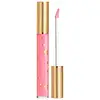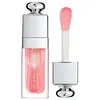What's inside
What's inside
 Key Ingredients
Key Ingredients

 Benefits
Benefits

 Concerns
Concerns

 Ingredients Side-by-side
Ingredients Side-by-side

Polybutene
Octyldodecanol
EmollientHydrogenated Polyisobutene
EmollientSilica
AbrasiveEthylhexyl Palmitate
EmollientHelianthus Annuus Seed Wax
Skin ConditioningMenthyl Lactate
MaskingAroma
Caprylic/Capric Triglyceride
MaskingParfum
MaskingMethyl Nicotinate
SoothingOctyldodecyl Stearoyl Stearate
EmollientTrihydroxystearin
Skin ConditioningPentaerythrityl Tetraisostearate
EmollientCapsicum Frutescens Fruit Extract
Skin ConditioningGlycine Soja Oil
EmollientZingiber Officinale Root Oil
MaskingAlpha-Isomethyl Ionone
PerfumingSodium Hyaluronate
HumectantLinalool
PerfumingBenzyl Salicylate
PerfumingCitronellol
PerfumingRosa Hybrid Flower Extract
Skin ConditioningCI 77891
Cosmetic ColorantCI 45410
Cosmetic ColorantCI 19140
Cosmetic ColorantPolybutene, Octyldodecanol, Hydrogenated Polyisobutene, Silica, Ethylhexyl Palmitate, Helianthus Annuus Seed Wax, Menthyl Lactate, Aroma, Caprylic/Capric Triglyceride, Parfum, Methyl Nicotinate, Octyldodecyl Stearoyl Stearate, Trihydroxystearin, Pentaerythrityl Tetraisostearate, Capsicum Frutescens Fruit Extract, Glycine Soja Oil, Zingiber Officinale Root Oil, Alpha-Isomethyl Ionone, Sodium Hyaluronate, Linalool, Benzyl Salicylate, Citronellol, Rosa Hybrid Flower Extract, CI 77891, CI 45410, CI 19140
Hydrogenated Polyisobutene
EmollientTridecyl Trimellitate
EmollientPolybutene
Pentaerythrityl Tetraisostearate
EmollientPhytosteryl/Octyldodecyl Lauroyl Glutamate
Skin ConditioningEthylene/Propylene/Styrene Copolymer
Ethylhexyl Palmitate
EmollientCaprylic/Capric Triglyceride
MaskingButylene/Ethylene/Styrene Copolymer
Parfum
MaskingPolyglyceryl-2 Triisostearate
EmulsifyingLuffa Cylindrica Seed Oil
Skin ConditioningPrunus Avium Seed Oil
EmollientTrimethylolpropane Triisostearate
EmollientDiisostearyl Malate
EmollientTocopherol
AntioxidantPentaerythrityl Tetra-Di-T-Butyl Hydroxyhydrocinnamate
AntioxidantUndaria Pinnatifida Extract
Skin ConditioningBenzyl Alcohol
PerfumingPropyl Gallate
AntioxidantCI 12085
Cosmetic ColorantCI 15850
Cosmetic ColorantCI 15985
Cosmetic ColorantCI 17200
Cosmetic ColorantCI 19140
Cosmetic ColorantCI 42090
Cosmetic ColorantCI 45380
Cosmetic ColorantCI 45410
Cosmetic ColorantCI 73360
Cosmetic ColorantCI 77163
Cosmetic ColorantCI 77491
Cosmetic ColorantCI 77492
Cosmetic ColorantCI 77499
Cosmetic ColorantCI 77742
Cosmetic ColorantCI 77891
Cosmetic ColorantHydrogenated Polyisobutene, Tridecyl Trimellitate, Polybutene, Pentaerythrityl Tetraisostearate, Phytosteryl/Octyldodecyl Lauroyl Glutamate, Ethylene/Propylene/Styrene Copolymer, Ethylhexyl Palmitate, Caprylic/Capric Triglyceride, Butylene/Ethylene/Styrene Copolymer, Parfum, Polyglyceryl-2 Triisostearate, Luffa Cylindrica Seed Oil, Prunus Avium Seed Oil, Trimethylolpropane Triisostearate, Diisostearyl Malate, Tocopherol, Pentaerythrityl Tetra-Di-T-Butyl Hydroxyhydrocinnamate, Undaria Pinnatifida Extract, Benzyl Alcohol, Propyl Gallate, CI 12085, CI 15850, CI 15985, CI 17200, CI 19140, CI 42090, CI 45380, CI 45410, CI 73360, CI 77163, CI 77491, CI 77492, CI 77499, CI 77742, CI 77891
 Reviews
Reviews

Ingredients Explained
These ingredients are found in both products.
Ingredients higher up in an ingredient list are typically present in a larger amount.
This ingredient is an emollient, solvent, and texture enhancer. It is considered a skin-softener by helping the skin prevent moisture loss.
It helps thicken a product's formula and makes it easier to spread by dissolving clumping compounds.
Caprylic Triglyceride is made by combining glycerin with coconut oil, forming a clear liquid.
While there is an assumption Caprylic Triglyceride can clog pores due to it being derived from coconut oil, there is no research supporting this.
Learn more about Caprylic/Capric TriglycerideCI 19140 is also known as Tartrazine. Tartrazine is a synthetic dye used in cosmetics, foods, and medicine to add a yellow color.
Tartrazine is created from petroleum and is water-soluble.
Some people may experience allergies from this dye, especially asthmatics and those with an aspirin intolerance.
Learn more about CI 19140CI 45410 is a synthetic red-pigment and dye.
It often goes by both Red 28 or Red 27; manufacturers label both ingredients as CI 45410.
This dye is commonly found in makeup because it imparts a vivid color. Some types of this dye change color based on pH level and interaction with moisture:
Your skin has a natural pH of around 4.5 - 5.5.
According to the FDA, CI 45410 is not permitted for use in eye products.
Red 27 is a flourescein dye and commonly used as a fluorescent tracer in medicine.
Learn more about CI 45410Ci 77891 is a white pigment from Titanium dioxide. It is naturally found in minerals such as rutile and ilmenite.
It's main function is to add a white color to cosmetics. It can also be mixed with other colors to create different shades.
Ci 77891 is commonly found in sunscreens due to its ability to block UV rays.
Learn more about CI 77891Ethylhexyl Palmitate, also known as octyl palmitate, is created from 2-ethylhexyl alcohol and palmitic acid. It is a fatty acid ester.
The fatty acid content of Ethylhexyl Palmitate makes it an emollient. Emollients help soften and hydrate your skin by trapping moisture within.
Ethylhexyl Palmitate is also used to help improve the texture of cosmetics. It helps other ingredient dissolve in products and help disperse ingredients more evenly.
You'll likely find this ingredient in sunscreen, as it is often used to mix UV-blocking ingredients such as avobenzone and ethylhexyl triazone.
It can also help stabilize the fragrances in a product as a fragrance fixative.
Ethylhexyl Palmitate can be used to substitute mineral oil.
Due to its high fatty acid content, it may not be fungal-acne safe.
Learn more about Ethylhexyl PalmitateHydrogenated Polyisobutene is a synthetic polymer. Polymers are compounds with high molecular weight. Hydrogenated Polyisobutene is an emollient and texture enhancer.
In one study, Hydrogenated Polyisobutene showed better skin hydration levels than Caprylic/Capric Triglyceride. As an emollient, it helps keep your skin soft and hydrated by trapping moisture in.
Hydrogenated Polyisobutene is often used as a mineral oil replacement.
Learn more about Hydrogenated PolyisobuteneParfum is a catch-all term for an ingredient or more that is used to give a scent to products.
Also called "fragrance", this ingredient can be a blend of hundreds of chemicals or plant oils. This means every product with "fragrance" or "parfum" in the ingredients list is a different mixture.
For instance, Habanolide is a proprietary trade name for a specific aroma chemical. When used as a fragrance ingredient in cosmetics, most aroma chemicals fall under the broad labeling category of “FRAGRANCE” or “PARFUM” according to EU and US regulations.
The term 'parfum' or 'fragrance' is not regulated in many countries. In many cases, it is up to the brand to define this term.
For instance, many brands choose to label themselves as "fragrance-free" because they are not using synthetic fragrances. However, their products may still contain ingredients such as essential oils that are considered a fragrance by INCI standards.
One example is Calendula flower extract. Calendula is an essential oil that still imparts a scent or 'fragrance'.
Depending on the blend, the ingredients in the mixture can cause allergies and sensitivities on the skin. Some ingredients that are known EU allergens include linalool and citronellol.
Parfum can also be used to mask or cover an unpleasant scent.
The bottom line is: not all fragrances/parfum/ingredients are created equally. If you are worried about fragrances, we recommend taking a closer look at an ingredient. And of course, we always recommend speaking with a professional.
Learn more about ParfumPentaerythrityl Tetraisostearate is derived from isostearic acid. It is an emollient and emulsifier.
The highest concentration of this ingredient is found in lipsticks.
This ingredient is minimally water soluble and may not be Malassezia folliculitis, or fungal-acne safe.
Learn more about Pentaerythrityl TetraisostearatePolybutene is used to help control the viscosity of a product. This just means it helps adjusts the texture.
It is a polymer and does not get absorbed into the skin due to its large size.
Studies found this ingredient did not irritate skin in concentrations below 15%.
Learn more about Polybutene